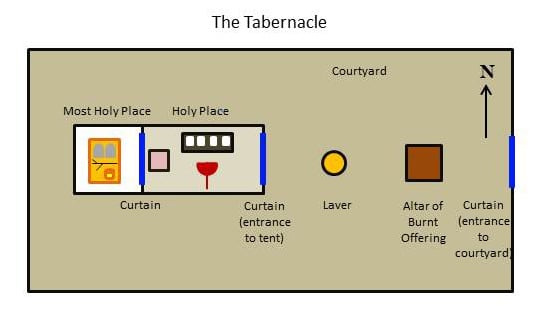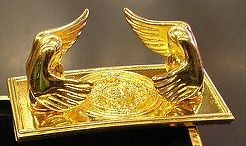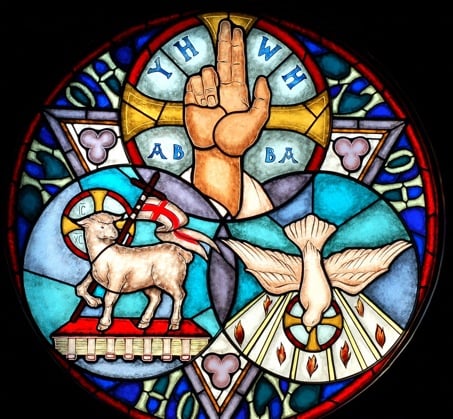The Tabernacle

The Garden is the name I have given to the first five verses of the NIV Bible. [1] The Garden so densely encrypted with numbers as to justify the appellation 'holographic' and constitutes a matrix of interlocking numbers of incredible beauty, apparently limitless information and unfathomable complexity. For example, as displayed here, the miracles God performed on each of the six days of Creation are encoded within those verses.
A unique feature of these encodings is a phenomenon I have called the double witness. Each concept is found twice, in biblical Hebrew (from the Masoretic text) and modern English (from the NIV Bible, encoded as two numbers that are always found together within the text. [2] The numbers are derived from the first appearance of the concept in the Masoretic and the equivalent words in the NIV, so there was no cherry picking. All this is statistically improbable; the consistent pairing of Hebrew and English in this manner is a double witness to God's creative power, and speaks of a grand design rather than mere chance.
Within the Garden lies a sanctuary, the Tabernacle, used by the Israelites for worship and sacrifice. The Tabernacle was a portable temple, built according to the instructions given to Moses on Mount Sinai. It consisted of the Tent of Meeting (the tabernacle proper), surrounded by a courtyard. The tent itself was divided into the Holy Place and the Most Holy Place. All three parts were furnished and had an entrance. The most important item of furniture and the only material object the Israelites considered sacred was the Ark of the Testimony and its contents.
The entire structure, its parts and its contents are present in the Garden, the presence of each item witnessed in both biblical Hebrew and modern English. This is part of the miracle of miracles, to which I, stumbling, was led after fifteen years of struggling to unlock the New Bible code.
Part 1: The Structure
We will approach the tabernacle from east to west as if we are an Israelite entering for worship: the High Priest himself in fact, the only Israelite who could enter all the way to the Most Holy Place. First we behold the entire compound in the distance . . .
The Tabernacle
"Then have them make a sanctuary for me, and I will dwell among them. Ex. 25.8

The tabernacle is first mentioned in the verse above, where it is referred to as 'a sanctuary'. Appropriately, the structure is found in the middle of the Garden, as a particularly good double encoding. In fact both numbers are found twice, the other two word blocks sitting side by side, covering words 10 to 39 (1446) and words 40 to 50 (444). So there is a double, double encoding here. As usual I've only shown one of them for clarity.
The proper name 'The Tabernacle', first found in Exodus 26.1, is also found in the Garden. THIS SHOULD BE LATER
"Make the tabernacle with ten curtains of finely twisted linen and blue, purple and scarlet yarn, with cherubim worked into them by a skilled craftsman. Ex. 26.1

The Entrance to the Courtyard
As we approach the structure from its east side we see the entrance to the courtyard, the first of three we have to pass through.
For the entrance to the courtyard, provide a curtain twenty cubits long, of blue, purple and scarlet yarn and finely twisted linen - the work of an embroiderer - with four posts and four bases. Ex. 27.16

The phrase taken from the NIV includes 'for', which has to be there because it is part of the translation of the Hebrew words. So we pass through the entrance into the courtyard itself.
The Courtyard
The Entrance to the Tent
The Tent of Meeting
The Holy Place
(Ex. 26.33)
The Curtain
The Most Holy Place
(Ex. 26.33)
Part 2: The Furnishings
Now as High Priest we enter a second time, this time stopping at each item of furniture in the Tabernacle.
The Altar of Burnt Offering
The Bronze Basin
The Lampstand
The Bread of the Presence
The Altar of Incense
The Ark of the Testimony
Part 3: The Ark
The Ark of the Testimony
There, above the cover between the two cherubim that are over the ark of the testimony, I will meet with you and give you all my commands for the Israelites. Ex. 25.22

The proper name for the ark is first found in the quoted verse, and the two numbers were taken from the Masoretic and its precise translation in the NIV Bible. Note that the definite article (the) is included here, since that is part of the NIV translation. [1] There is no reason why these numbers should be found within the same word string, yet they are, in a tight pairing near the beginning of the NIV. This is the precise location which an elegant little ELS code identifies as the location for the ark.
The Ark was composed of several parts, all of which have deep significance. The details of their contruction are described in Exodus.
The Chest
Have them make a chest of acacia wood - two and a half cubits long, a cubit and a half wide and a cubit and a half high. Ex. 25.10

Unusually, the two pairings do not overlap, but they are fairly closely aligned nonetheless, with only one word separating them.
The dimensions of the chest are discussed here. The material of construction is acacia wood, which I will hopefully discuss in a later page [3]
The Atonement Cover
Make an atonement cover of pure gold - two and a half cubits long and a cubit and a half wide. Ex. 25.17

The indefinite article 'an' is part of the English translation of Kaporeth and so had to be included. This is a particularly good alignment, as we might expect for the article representing Christ, our atonement cover. The words 'atonement cover' are found over the first twenty-four words, as part of another suite of encoded numbers, discussed here.
The Moulding
Overlay it with pure gold, both inside and out, and make a gold moulding around it. Ex. 25.11

The moulding is the crown that was fashioned around the rim of the atonement cover - and this is a particularly well-fashioned encoding! The Hebrew word zer is also found in the small overlapping string from words 47 to 51. Other than that, these are the only instances of the numbers 207 and 500 in the Garden.
The Cherubim of the Glory
And make two cherubim out of hammered gold at the ends of the cover. Ex. 25.18

The separation between the Hebrew and English numbers within the Garden caused me some consternation at first, as I had formed the conviction that they had to be close or overlapping for it to be considered a possible encoding. But God's creativity is boundless and it eventually occured to me that the large space between the numbers might be a deliberate reflection of the positioning of the two cherubim at either end of the atonement cover on the ark.

It also occured to me that if this really were an encryption, other numbers would confirm it - and this is in fact the case.
The space between the two cherubim was where the Glory of the Lord manifested. The 'space' between the two numbers in the Garden has an ordinal value of 1255, which is the standard value of the first biblical instance of the word qadash, which means consecrate or sanctify. The Glory of the Lord consecrates the sanctuary, as we are told in Exodus 29.42-43.
"For the generations to come this burnt offering is to be made regularly at the entrance to the Tent of Meeting before the Lord. There I will meet you and speak to you; there also I will meet with the Israelites, and the place will be consecrated by my glory." Ex. 29.42-43

The NIV translates qadesh as 'consecrate', which is also found in the 'Glory' space - and which begins at the same word!
The Glory residing between the cherubim is also found in two amazingly symmetrical encodings, staight from Psalm 19.
The heavens declare the glory of God; the skies proclaim the work of his hands. Ps. 19.1

The centre of the Garden, the midpoint of two cherubim encodings and the centre of 'the Glory of God' encodings in both Hebrew and English are all the same point - between words 41 and 42! I think this is enough evidence to convince us that the word blocks representing the Hebrew and English words for cherubim were deliberately set apart to symbolise the cherubim above the ark, and that the space between them is filled with the Glory of God.
The Rings
The Poles
There are four items associated with the ark, all of which are found alongside it in the Garden.
Aaron's Staff
The Jar of Manna
The Two Tablets
The Law
Summary
Notes
1. New International Version (NIV) Bible, 1984 (2001 reprint) in British English. This part of the code was also present in the US English version and is preserved in the latest edition of the NIV Bible (British and US English).
2. This part of the code was also double witnessed: by myself and researcher Kathryn LeCorre, who received the revelations that led me to find it.
3. The tree of life described in Revelation is the pattern made by interfering waves. The branches of an acacia tree picture it quite well and this I believe is why the ark, the bringer of life from God, was made from acacia wood.
